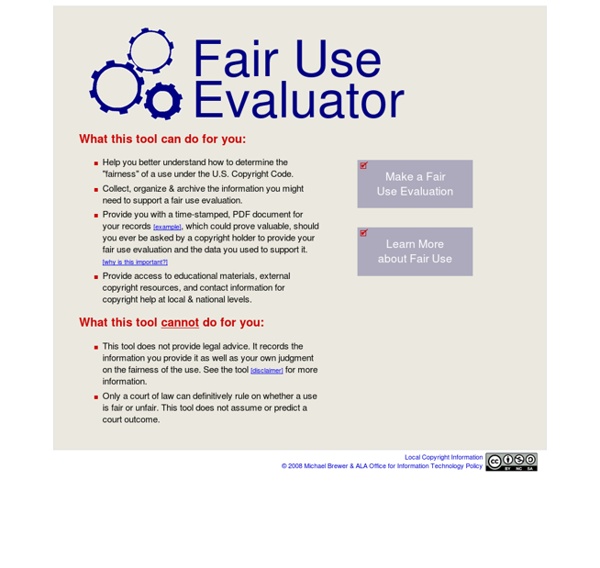



http://librarycopyright.net/resources/fairuse/index.php
Related: Intellectual property/ethics: Creative Commons, Copyright, Fair Use, Public Domain, CC0Intermediate Web Literacy I: Intro to CSS Do the activity on your own to become familiar with fair use, open licensing, copyright, search, reverse-image search, and embedding images in a webpage. Follow this link to the Thimble project for this activity. Click on the green "Remix" button in the upper right-hand corner of the window to go into the project's code. Click on the "Tutorial" pane next to the "Preview" pane in the upper right-hand corner of the coding window.
Measuring Fair Use: The Four Factors - Copyright Overview by Rich Stim - Stanford Copyright and Fair Use Center Unfortunately, the only way to get a definitive answer on whether a particular use is a fair use is to have it resolved in federal court. Judges use four factors to resolve fair use disputes, as discussed in detail below. It’s important to understand that these factors are only guidelines that courts are free to adapt to particular situations on a case‑by‑case basis. In other words, a judge has a great deal of freedom when making a fair use determination, so the outcome in any given case can be hard to predict. The four factors judges consider are:
A Copyright-Friendly Toolkit However fabulous Creative Commons and Public Domain content may be, sometimes you really need to use copyrighted material. Say you plan to comment on popular media or current events. For instance, you may be planning to critique the portrayal of Native Americans in commercial films. You are going to want to “quote” some commercial films like Pocahontas, Lone Ranger, and Dances with Wolves.
Even Weird Al Gets Permission – American University Intellectual Property Brief If you’re on the Intellectual Property Brief website, odds are that you know what fair use is. The doctrine of fair use is one of the most important features of United States copyright law, and the need for its preservation cannot be overstated. The American University Center for Social Media has some excellent definitions of fair use: “Fair use is the right, in some circumstances, to quote copyrighted material without asking permission or paying for it. It is a crucial feature of copyright law. In fact, it is what keeps copyright from being censorship.
Fair Use and Other Educational Uses Using copyrighted material in your teaching Fair Use - the basics of "fair use" Rules of Thumb - help for determining if your use is "fair use" Educational Guidelines - additional guidelines for thinking about "fair use" Fair Use
Fear of Missing Out Attention, social media addicts: leading a "wired" life where one is constantly tuned into social media sites causes an unwanted side effect called FOMO (Fear of Missing Out). Someone suffering from FOMO may check social media sites like Facebook, Twitter or Four Square frequently to make sure they are not "missing" out on anything. On a typical afternoon, NBC New York visited Madison Square Park in Manhattan, to see how often New Yorkers are checking in.
Fair use and transformativeness: It may shake your world I am no longer sure that anything I learned, or anything I regularly share relating to fair use, is either helpful or relevant. As a gatekeeper, I’ve been far too conservative. As I watched the information and communication landscapes shift over the past few years, I secretly viewed fair use as a doctrine that guided what we couldn’t do. Welcome - Copyright Crash Course - LibGuides at University of Texas at Austin The Copyright Crash Course was created by Georgia Harper and is currently maintained by UT Libraries. The Course is arranged into several sections that allow users to explore certain areas of copyright law individually or as a group. The Course was originally created with faculty in mind, but can be used by anyone who is interested in understanding and managing their copyrights. If you need to take the Crash Course tutorial & test, click here (UT affiliation required). Version 1 of the Copyright Crash Course is available via Texas ScholarWorks. You are using Version 2.
Can we break free from the fear of missing out? – Jacob Burak Here’s a test you might enjoy: rate these scenarios on a number scale, ranging from 1 for mild discomfort to 7 for outrageous distress. Scenario 1: you’re flicking through news websites, as you do every morning. Today, however, you’re behind schedule and have only 15 minutes to read articles, instead of your usual 30. You have to skip some of your favourite columns and sections. The Information Literacy User’s Guide: An Open, Online Textbook Now that you have gone through the processes involved to find and evaluate information, the next step is to start working with it. This is where the Manage pillar comes in: it focuses on the need to organize information professionally and ethically. Individuals understand:
Guide to Finding Interesting Public Domain Works Online Overview This guide is intended to assist people who are interested in exploring interesting works which have entered the public domain. It covers: 1.